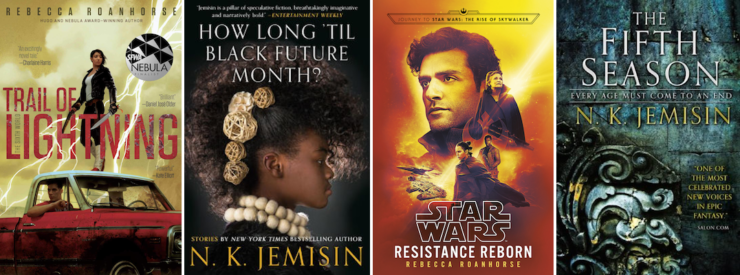“I grew up reading the same white boys on quests that everyone else did,” Rebecca Roanhorse said at BookCon’s most excellent Mashup of Time, Space, and Media, as the Trail of Lightning author sat down with N.K. Jemisin to talk creating and adapting speculative fiction. A mashup of time, or perhaps a freezing of it—the conversation lasted a mere half hour, yet every minute was interesting. From these two women of color commiserating over the white boy quests they read in childhood, to writing figures more like themselves into future quests, this panel was as varied as the definition of spec fic itself.
Check out the live-tweet of the panel below!
Next up! A Mashup of Time, Space, and Media: @nkjemisin and @RoanhorseBex on Creating and Adapting Speculative Fiction #BookCon19
What kind of spec fic did they read while growing up?
@RoanhorseBex: “I grew up reading the same white boys on quests that everyone else did.” Same for @nkjemisin, who had it lodged in her head that “only white boys were important enough to have stories centered around them.”
“I was writing for myself,” @RoanhorseBex says, “but I was writing white boys on quests.” And @nkjemisin was led to believe that only men wrote SF and it was “better,” and only women wrote fantasy and it was “weak.” Roanhorse stayed away from genre until she found urban fantasy.
Talking terminology: “Speculative fiction” is an easier term than listing everything it contains. “Magical realism” can pigeonhole Latinx writers “whether they like it or not,” but no one would begrudge those who make a living writing magical realism.
@nkjemisin talks about the balance of being trapped between whatever people expect of you and retaining the freedom to creatively grow and spread, constantly feeling that tension. #BookCon19
Both authors would call themselves pantsers AND plotters.
@RoanhorseBex’s #StarWars #TheRiseofSkywalker book Resistance Reborn “has to be plotted to the nth degree” what with outline approvals and Lucasfilm notes.
@nkjemisin: “I *have* to plot… My nature is to pants.”
When writing in second person, @nkjemisin says, you have to think about two characters—who’s speaking, who’s being spoken to.
@RoanhorseBex first wrote “Welcome to Your Authentic Indian Experience(TM)” in third person; rewriting in second person “really opened [it] up for me.”
@RoanhorseBex was introduced to the kinds of Navajo stories that inspired #TrailofLightning through the foundation of Navajo law.
However, @RoanhorseBex says, “This is not a cultural text. I’m not here to teach you Navajo ways. This is a story for Navajo readers, and non-Navajo readers, and if it gets you interested in learning more about Navajo culture, by all means talk to more Navajo folks.”
How much, if at all, have video games provided inspiration for spec fic? Dragon Age was a big inspiration for @nkjemisin’s Broken Earth trilogy. @RoanhorseBex isn’t a big video game fan, but she definitely watched #StarWarsBattlefront to write Resistance Reborn.
“Speculative fiction started as a term to bring it into the mainstream,” @nkjemisin says, “and I don’t think it worked.” Writing her column for the NYT, they didn’t know what spec fic was. “But what did happen is that SF became less of a stigma-bearing term itself.” #BookCon19
And that’s a wrap on the spec fic panel! #BookCon19










